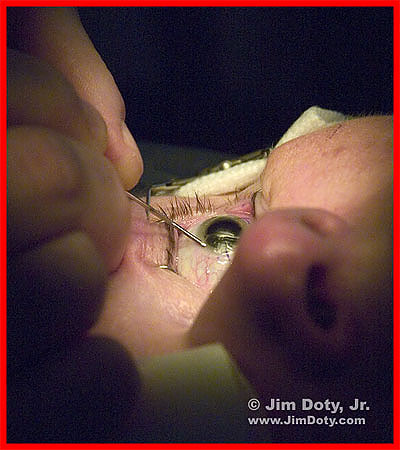RAW FILES - A DIGITAL "TOWER OF BABEL" Eye surgery. Canon 10D, "RAW" mode. Photo copyright(c) Jim Doty, Jr.
Eye surgery. Canon 10D, "RAW" mode. Photo copyright(c) Jim Doty, Jr.
I have a love-hate relationship with "RAW" digital camera files. I love the capabilities inherent in RAW capture, but processing the raw files is such a pain. Several things have happened, no thanks to the camera manufacturers, to improve the situation.
If your digital camera can write files in RAW or Jpeg, I've covered the differences in the
RAW vs JPEG article at my
photo website.
The first problem is that the software that camera manufacturers provide to convert RAW files is usually, slow, clunky, and inadequate. Many photographers have resorted to buying some kind of aftermarket conversion software. That is a step in the right direction but it shouldn't be necessary. Fortunately, RAW conversion now is built into Adobe Photoshop CS and Adobe Photoshop Elements 3.0. Bravo for Adobe!
The second problem is that each brand of camera has its own version of RAW files. There is no guarantee that the RAW files you can read today will be readable 10 years from now. The proprietary format may change and current software may no longer be available to read your old RAW camera files. Mike Johnston calls this a digital "Tower of Babel". Jpeg, psd (photoshop) or tiff file formats are virtually universal and will be readable long into the future. Not so with your camera's RAW files.
Once again, Adobe to the rescue with the new
DNG file format, which should, if manufacturers were at all sensible, become the new universal RAW file standard. Adobe provides the conversion software to change your camera brand RAW files into DNG files.
But you shouldn't need to go through all of this hassle. Cameras should write in the DNG file format to begin with. I was going to write about this, but Mike Johnston did just that and did it well. Mike gave me permission to reproduce the entire article on this blog. Thanks Mike.
*** *** ***
One Part of the Future is Nowby Mike Johnston
DNG stands for "Digital NeGative." It's a standardized RAW format.
Until now, each of the manufacturers has had its own proprietary RAW
format ("RAW" simply meaning direct capture, the state of the digital
data before any processing is applied). What this means is that each
manufacturer has to provide its own software for converting its own
proprietary RAW format.
It also means that independent software must provide a whole array of
conversion capabilities in order to claim to be practical. Adobe
recently added a program called "Adobe Camera Raw" (ACR) to Photoshop
CS and Photoshop Elements 3. ACR can convert RAW files from a number of
different cameras (as can Phase One C1 and a few others). But,
obviously, it complicates matters a lot for the software developers
when they have to constantly work to add more cameras to their
"supported" list. Plus, there's a delay between new cameras appearing
and independent RAW support appearing.
What DNG promises to do is to make a universal RAW standard so that any
RAW file can be downloaded into any raw converter application, with no
compatibility problems.
Here's a link to the Adobe page.
http://www.adobe.com/products/dng/main.htmlThe next camera I buy, regardless of whether it's a "digicam" or an
SLR, will be native DNG. As a general observer of the photography
scene, including the industry, the retail level, the profession, and
the hobby, I think DNG is the single most crucial development in
digital photography so far in this century. Well, maybe that's
hyperbole. But, to my mind, it's critically, critically important that
the industry as a whole moves away from the "Tower of Babel" approach
in which we're very rapidly getting mired.
Adobe is simply the perfect company to lead the way to a standard.
Adobe controls the TIFF and PDF standards, and has done great things
for the world's technical culture by making those standards free and
open. It has also, by those precedents, proven its trustworthiness with
regard to its motives. It may not be widely known yet, but Adobe has
even offered to turn over the DNG standard to an independent standards
organization if need be.
DNG has far too many advantages for any of us to be anything but
traitors to our love of photography if we fail to support it. (Possible
hyperbole alert again.) We will, on the one hand, reap numerous direct
rewards: just to list a few, new cameras will be immediately adaptable
to our existing workflows; software companies will be free to innovate;
cameras will be cheaper because camera manufacturers won't have to do
double-duty as software developers; and pro cameras won't have to waste
valuable CPU power on processing – they can simply be designed to
create small JPEGs for LCD display and rough editing, and otherwise
just shunt a DNG as quickly as possible directly to storage. And no,
you can't do that with proprietary raw standards because you can't
count on everybody being able to handle proprietary raw! If every
program made can handle DNG, on the other hand, it becomes possible.
For consumers, DNG will mean the return of viable commercial photo
processing (even if it's kiosks).
The long-term indirect advantages are compelling, too. Greater
accessibility for files; more robust development of the standard;
improved viability for smaller, less dominant camera makers; the list
goes on.
Personally, everything I shoot will be DNG from now on. And as I say, I
will not be buying another digital camera that doesn't write directly
to raw using DNG. I am even, as of now, throwing away the proprietary
raw files of my pictures, and keeping only the DNG files. Silly? Maybe.
Call it a "photopolitical commitment"...to the future.
*** *** ***
A shorter version of Mike article appears toward the bottom of
this page.
Visit Mike's website at
The 37th Frame.